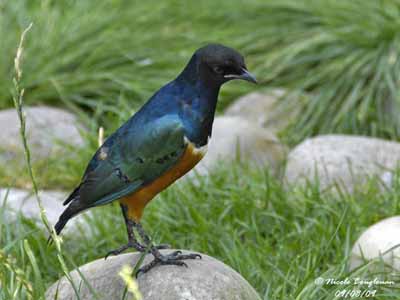
Fr: Choucador superbe
All : Dreifarben-Glanzstar
Esp : Estornino Soberbio
Ital: Storno splendido
Nd: Driekleurige Glansspreeuw
Text and pictures by Nicole Bouglouan
Captive birds in the London Zoo.
Sources :
HANDBOOK OF THE BIRDS OF THE WORLD Vol 14 by Josep del Hoyo-Andrew Elliot-David Christie - Lynx Edicions –
ISBN: 9788496553507
L’ENCYCLOPEDIE MONDIALE DES OISEAUX - Dr Christopher M. Perrins - BORDAS - ISBN: 2040185607
BIRDS OF AFRICA SOUTH OF THE SAHARA by Ian Sinclair and Peter Ryan - Princeton University Press Princeton and Oxford - ISBN: 0691118159
Wikipedia (Wikipedia, The Free Encyclopedia)
Superb Starling
Lamprotornis superbus
Passeriforme Order – Sturnidae Family
BIOMETRICS:
Length: 18 cm
Weight: 52-77 g
DESCRIPTION:
The Superb Starling is endemic to north-east Africa where it is resident and widespread.
Both adults are similar.
Adult has glossy blue-green upperparts, with darker blue tinge on the nape. Upperwing is rather glossy metallic green, with black spots on the coverts’ tips. The tail is relatively short and glossy blue-green.

On the underparts, chin, throat and breast are similar to the upperparts. A narrow white band crosses the breast. Belly, flanks and thighs are chestnut. Undertail coverts are white. On the underwing, coverts are white too.
Head is bronzy-black on crown and ear-coverts.
The bill is black. Eyes are whitish. Legs and feet are black.

The juvenile is duller than adults with less gloss on wings and tail. It has the colours of the adult plumage, but the white breast band is indistinct.
Eyes are very dark. Bill is whitish to yellowish. Legs and feet are pinkish-grey.

VOICE: SOUNDS BY XENO-CANTO
The Superb Starling utters some “chirr” and a repeated “whit-chor-chi-vii” when excited or alarmed. The flight call is a “skrrrri”.
The song is a protracted warbling, including trilling and chattering. This quiet and melodious song may be uttered by both sexes, but mainly by the male, often from a perch in shady tree during the middle of the day.
HABITAT:
The Superb Starling frequents open scrub and woodland, even in very arid areas. It is also found in gardens and cultivated areas, lakeshores and close to human habitations.
It usually avoids the humid lowlands, but it is seen mostly below 2200 metres of elevation.
RANGE:
The Superb Starling is resident in its range in East Africa, including SE Sudan, NE Uganda, Ethiopia, Somalia, Kenya and Tanzania.
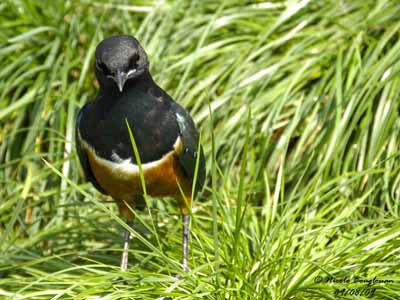
BEHAVIOUR:
The Superb Starling feeds mainly on varied species of insects, but it also takes berries and fruits, and nectar for some plants.
Insects are usually taken from the ground, as fruit and seeds. It may approach human settlements where it scavenges and takes the remains of meals and begs for food around the lodges and the picnic areas. This species is very popular among tourists.
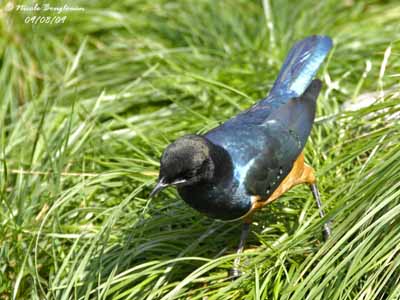
This bird is usually found in large flocks. Outside the breeding season, they gather at night in roosts which may contain from small groups to thousands of birds.
During the breeding season, this usually monogamous species can also be a co-operative breeder. They live in groups of potential breeders and helpers. If females mate with several males within the group, that involves additional helpers to feed the chicks. But to mate with other males outside the group, offers greater genetic variability in young.
Some courtship displays are observed, with birds running on the ground, performing jumps with dropping wings and head outstretched.
The female solicits the male by leaning forwards with raised tail and fluttering, dropped wings.
Then, both sexes cock the tail in order to display the white undertail-coverts.
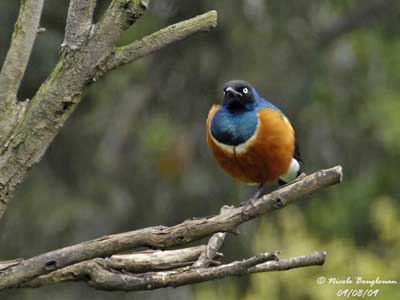
FLIGHT:
The indentations of the inner webs of some primary flight feathers involve a loud swooshing sound during the flight. The sounds produced may play a role in flock cohesion, and are an involuntary criterion of the species. There is no sexual dimorphism in the wing structure.
REPRODUCTION:
Breeding season varies according to the range.
The Superb Starling is primarily monogamous, but females may mate with other males of the group, and sometimes with non-members of this group.
They are co-operative breeders and numerous breeding pairs have helpers, often male’s offspring from previous broods. These helpers may provide nest material, and contribute in feeding the young, but not the female at nest.
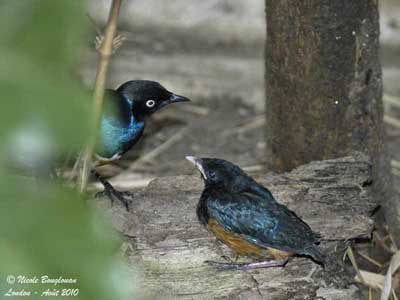
The nest is relatively large, a domed structure with side entrance. It is made with twigs, and the interior is lined with grass and some feathers. It is placed between 1, 50 and 6 metres above the ground, and usually in thorny tree which provides good protection.
This species may also use holes in trees or even in cliffs, but they also take over nests of other species after ejecting the eggs.
Female lays 4 dark blue eggs, and incubates alone during about 12-14 days. Chicks are fed by both adults and by helpers. Young fledge about 17-25 days after hatching, but they still depend on parents and helpers for food for 4-7 weeks after leaving the nest.
Their nest can be parasitized by the Great Spotted Cuckoo in Kenya.
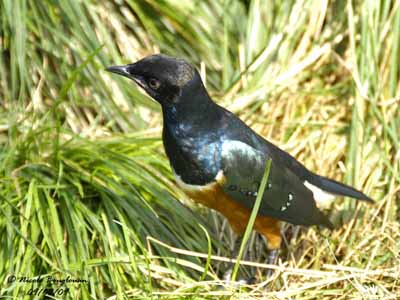
DIET:
The Superb Starling feeds mainly on insects caught on the ground such as beetles, flies, ants, termites, grasshoppers, mantids and caterpillars. They also consume berries and small fruits of several plant species, and nectar from Agave sisalana.
The Superb Starling runs and hops on the ground, often in small groups of up to 12 or more birds.
PROTECTION / THREATS / STATUS:
The Superb Starling is abundant and widespread in its range. The species is not threatened at this moment.
